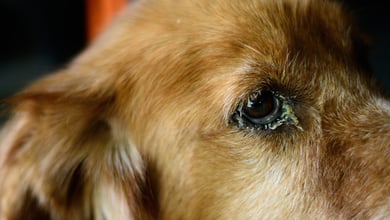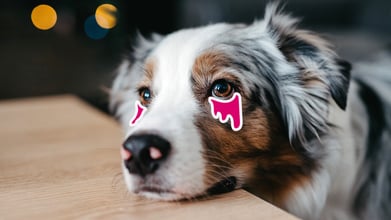Dog Eye Discharge: Types, Causes, Treatments

Table of Contents
Eye discharge is a common problem in dogs. From pups to seniors and Chihuahuas to Great Danes, any and every kind of dog can end up with eye discharge at some point in their lives.
But what causes these different kinds of discharge – and how can we treat them?
Our vets will give you a rundown of the possible diagnoses – and tell you when you need to book an appointment.
- Eye discharge in dogs can have different appearances and can indicate various conditions.
- Yellow discharge is often caused by a bacterial infection in the eye. Infections, corneal ulcers, and wounds on the eye's surface are typically treated with antibiotics.
- Prompt treatment is important to prevent complications and potential loss of the eye.
Types of Dog Eye Discharge
Eye discharge in dogs can have many different appearances. Some kinds of discharge are more commonly seen with certain illnesses, and the kind of discharge your dog has can help to understand how serious your dog’s condition is.
Crusts
Small crusts at the corner of your dog’s eyes can be quite normal, especially if they appear overnight and are easily wiped away. However, larger crusts that extend around the eyelids are not normal and are usually seen with other kinds of eye discharge.
Watery Discharge
Thin, watery eye discharge in dogs is often seen with allergies. It can also happen in the early stages of an eye infection or if your dog has suffered some damage to the eye, such as a corneal abrasion (a scratch on the surface of the eye).
Green or Yellow Sticky Discharge
More serious eye conditions can produce a thick, sticky green or yellow eye discharge in dogs. This often happens with bacterial eye infections but can also be seen with other conditions such as corneal ulcers, entropion, or dry eye. Sticky discharge from the eyes in dogs often indicates a more serious problem than a watery discharge.
Bloody Discharge
Trauma to a dog’s eye, such as from a cat scratch or a stick poke, can lead to bleeding from the eye and a bloody eye discharge. This kind of bloody discharge is a sign of serious problems with the eye.
Hassle-free In-Home Pet Sick Visits
When your pet isn't feeling well, the last thing you want is a stressful trip to the vet. Our in-home sick pet visits offer a calm, stress-free alternative.
7 Common Causes of Dog Eye Discharge
Dog eye discharge can have various causes, including infections, allergies, foreign bodies, corneal abrasions, entropion, and dry eye. Here is a list further explaining these dog eye discharge causes:
1. Bacterial Infections
Bacterial infections are the most common cause of eye discharge in dogs and can be very painful. They usually cause a thick, sticky green discharge from the eye, though occasionally it can be cream or yellow instead.
Your dog’s eye may appear slightly swollen and they may shut their eye or keep the eyelids half-open.
Simple infections normally only affect one eye, but if the infection is caused by another problem (such as entropion or dry eye) then it may affect both eyes.
2. Allergies
Allergies are common in dogs and can cause redness, puffiness, and a watery discharge from both of the dog’s eyes. Your dog’s eyes may be itchy, and they may paw at their face or rub it along the floor to try and itch it.
Seasonal allergies may cause symptoms at the same time of year - for example, if they are caused by a particular pollen. Other allergies such as dust mites can cause problems year-round.
3. Foreign Bodies
A “foreign body” is an object that becomes trapped within the eye. The most common of these is a piece of grass, but it can also happen with other plant material (such as twigs or leaves), or with a piece of nail after a fight with another dog or cat.
Foreign bodies are often very painful, especially if they penetrate the cornea (the surface of the eye). They can cause discharge which may initially be watery but becomes thick and sticky if an infection takes hold.
4. Corneal Abrasion
A corneal abrasion is a cut or graze on the surface of the eye. These often happen when dogs are out on a walk, or occasionally after a fight with another dog or cat. They are painful and cause discharge that is usually watery unless an infection is also present.
5. Corneal Ulcers
These ulcers are more serious than abrasions and go much deeper into the surface of the eye. They are often caused by inflammation or infection and often cause a thick sticky green eye discharge. If these ulcers go too deep, they can cause the eye to rupture, at which point it will need to be removed.
Corneal ulcers are more common in brachycephalic (flat-faced) dogs such as Bulldogs, Pugs, Boxers, and Boston Terriers.
6. Entropion
If a dog has too much skin around their eyes, this can cause them to fold inward and lead to hairs rubbing on the surface of the eye. This condition is known as entropion and is very painful. It can also lead to infection and a thick, sticky green eye discharge.
Puppies of all breeds can be born with entropion or develop it as they grow. Adult dogs with extra skin around their eyes, such as brachycephalic (flat-faces) dogs, can also develop entropion later in life.
7. Dry Eye (Keratoconjunctivitis Sicca)
Dry eye is an auto-immune condition that leads to the tear glands being destroyed so the dog can no longer keep their eyes moist. This can weaken the eye and lead to bacterial infections and corneal ulcers if left untreated. Dry Eye often leads to a thick, sticky green eye discharge in dogs.
Home Remedies for Dog Eye Discharge
Crusts around the eye can easily be treated at home. Boil some water, allow it to cool, and then use moistened cotton wool to wipe gently around the eye. You can also use this technique to clean away other kinds of discharge, but it is not usually effective by itself to treat the cause of the discharge.
Other home remedies for dog eye discharge such as teas or herbal preparations are not effective at treating infection and may make the issue worse. If your dog has worsening eye discharge or discharge that is present for more than a few days, then you should visit your veterinarian.
Should My Pet Be Seen by a Veterinarian?
1. Have you noticed changes in your pet’s appetite?
2. Does your pet have diarrhea or loose stools?
3. Have you noticed changes in your pet’s thirst/water consumption?
4. Is your pet having accidents in the house?
5. Is your pet pacing and unable to settle?
6. Is your pet panting more than usual?
7. Is your pet whining or vocalizing more than usual?
8. Is your pet shaking more than usual?
9. Is your pet hiding or avoiding physical contact more than usual?
10. Is your pet more lethargic and sleeping more than usual?
11. Are you concerned about changes in your pet’s behavior?
12. Is your pet scratching their ears?
13. Is your pet licking their paws more than usual?
14. Does your pet have a rash?
15. Is your pet moving more slowly than usual or having a harder time getting up or down?
View Results
Should My Pet Be Seen by a Veterinarian?
1. Have you noticed changes in your pet’s appetite?
2. Does your pet have diarrhea or loose stools?
3. Have you noticed changes in your pet’s thirst/water consumption?
4. Is your pet having accidents in the house?
5. Is your pet pacing and unable to settle?
6. Is your pet panting more than usual?
7. Is your pet whining or vocalizing more than usual?
8. Is your pet shaking more than usual?
9. Is your pet hiding or avoiding physical contact more than usual?
10. Is your pet more lethargic and sleeping more than usual?
11. Are you concerned about changes in your pet’s behavior?
12. Is your pet scratching their ears?
13. Is your pet licking their paws more than usual?
14. Does your pet have a rash?
15. Is your pet moving more slowly than usual or having a harder time getting up or down?
Share Quiz
Treatment for Dog Eye Discharge
Green or yellow discharge from a dog's eye often indicates a bacterial infection, which can be treated with antibiotics prescribed by a veterinarian. It is essential to have your dog's eye examined by a professional to determine the underlying cause of the discharge.
Treatment may also include flushing out the eye, topical medication, or other interventions depending on the infection's severity and the symptoms' extent. Prompt treatment can prevent the infection from spreading and causing further complications.
Conclusion
There are several causes of eye discharge in dogs. Some of them are straightforward to treat, but others can cause a dog to lose an eye if they are not treated quickly.
If your dog has persistent eye discharge or discharge that is getting worse, then you should schedule a visit with a veterinarian to get them checked.
Frequently Asked Questions
How do I tell if my dog has an eye infection?
Dogs with an eye infection will usually have a thick, sticky green discharge from their eye. However, other illnesses can also cause these symptoms, so you should always get infections diagnosed by a veterinarian.
What home remedies are effective for dog eye discharge?
Dog eye discharge can be cleaned away gently using some cotton wool dipped in water that has been sterilized in boiling water and then allowed to cool. However, if your dog’s eye discharge persists, then you should see your veterinarian for a diagnosis.
When should I take my dog to the veterinarian for eye discharge?
A small amount of crusting at the corners of the eye is normal for dogs. However, if the amount of discharge starts to increase for more than a few days, then you should get it checked by a veterinarian. Any symptoms of pain – including a closed or half-closed eye, or pawing or rubbing at the eye – are also a sign that you should see your veterinarian.






